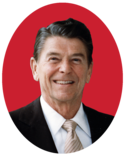| 1980 presidential election | |
  Nominees Reagan and Bush | |
| Convention | |
|---|---|
| Date(s) | July 14–17, 1980 |
| City | Detroit, Michigan |
| Venue | Joe Louis Arena |
| Keynote speaker | Guy Vander Jagt |
| Candidates | |
| Presidential nominee | Ronald Reagan of California |
| Vice presidential nominee | George H. W. Bush of Texas |
| Voting | |
| Total delegates | 1,990 |
| Votes needed for nomination | 996 |
| Results (president) | Reagan (CA): 1,939 (97.44%) Anderson (IL): 37 (1.86%) Bush (TX): 13 (0.65%) Armstrong (TX): 1 (0.05%) |
| Results (vice president) | Bush (TX): 1,832 (93.33%) Helms (NC): 54 (2.75%) Kemp (NY): 42 (2.14%) Crane (IL): 23 (1.17%) Thompson (IL): 5 (0.26%) |

The 1980 Republican National Convention convened at Joe Louis Arena in Detroit, Michigan, from July 14 to July 17, 1980. The Republican National Convention nominated retired Hollywood actor and former Governor Ronald Reagan of California for president and former Representative George H. W. Bush of Texas for vice president.[1]
Reagan, running on the theme "Let's Make America Great Again," stayed at the Detroit Plaza Hotel in the Renaissance Center, at the time the world's tallest hotel, and delivered his acceptance speech at Joe Louis Arena.[2] It remains the only major party national political convention to have been held in Detroit.
In addition to Reagan, Bush and keynote speaker Guy Vander Jagt; other notable speakers included former Treasury Secretary William E. Simon; former Defense Secretary Donald Rumsfeld and former President Gerald Ford (the convention's opening night coincided with Ford's 67th birthday, and following his speech Ford was presented with a check to help fund the Gerald Ford Presidential Library); former Secretary of State Henry Kissinger; Arizona Senator and 1964 Republican presidential nominee Barry Goldwater (introduced by his son, California Congressman Barry Goldwater Jr.); New York Congressman Jack Kemp; National Association for the Advancement of Colored People executive director Benjamin Hooks; Kansas Senator Nancy Kassebaum (introduced by a film by her father, 1936 Republican presidential nominee Alf Landon); former Texas Governor John Connally and former Ambassador to the United Kingdom Anne Armstrong.
Following victories in several delegate-rich primaries in April and early-May, the former governor had a lock on the nomination prior to the convention. His last remaining opponent in the race, George H. W. Bush, dropped out on May 26 and urged his supporters to back Reagan. Under party rules then in place, only Reagan's name was officially placed in nomination. Because of this, former contender John B. Anderson's goal having a speaker at the convention was thwarted.
| Candidate | Votes | % | |
|---|---|---|---|
| Ronald Reagan | 1,939 | 97.44 | |
| John B. Anderson | 37 | 1.86 | |
| George H. W. Bush | 13 | 0.65 | |
| Anne Armstrong | 1 | 0.05 | |
| Total votes | 1,990 | 100% | |
| Votes necessary | 996 | >50% | |
|
Main article: Republican Party vice presidential candidate selection, 1980 |
Reagan waited until the Convention in July to announce his choice of a running mate, as was customary at the time. A short list of prospective running mates was put together after Reagan clinched the presidential nomination, including Howard Baker, William Simon, Jack Kemp, Richard Lugar, Paul Laxalt and George Bush.[4]

Shortly before the convention, the possibility of choosing former President Gerald Ford as the vice presidential nominee was given some consideration. Ford asked for certain powers and prerogatives that have been described as making Ford a co-president (had he been chosen).[5][6] Negotiations for the terms of such an arrangement were held at the Hotel Pontchartrain.[5] These included the return of Henry Kissinger as secretary of State and the appointment of Alan Greenspan as secretary of the Treasury in a "package deal".[5][6]
On July 16, Ford was interviewed by Walter Cronkite. According to Bob Schieffer, "The whole convention came to a stop," when, after being asked by Cronkite, Ford did not dismiss rumors that Reagan was considering him as a running mate. However, negotiations ultimately fell apart later that day when the two sides could not come to an agreement.[5][6]
Reagan's selection of George Bush as his running mate unfolded after the negotiations with Ford reached an impasse, and was finalized less than 24 hours before the ticket was announced.[5][6] It was Richard Allen, then Reagan's chief foreign policy advisor, who suggested Bush as a viable alternative to Ford, believing that he possessed "the best credentials of the possible running mates mentioned".[4]

Even though Reagan had taken the unprecedented step of announcing his running mate choice from the podium of the convention himself, some delegates still resented Bush for defeating Reagan in a number of primaries, and especially the Iowa caucuses. In a direct challenge to Bush's nomination, they nominated Senator Jesse Helms to oppose him. The effort went nowhere, and Bush won by an overwhelming margin. This would be the last time during the 20th century that the bottom half of the ticket would be contested, as the rules would be changed in 1988 to prevent this from happening again.
| Candidate | Votes | % | |
|---|---|---|---|
| George H. W. Bush | 1,832 | 93.33 | |
| Jesse Helms | 54 | 2.75 | |
| Jack Kemp | 42 | 2.14 | |
| Phil Crane | 23 | 1.17 | |
| James R. Thompson | 5 | 0.26 | |
| Others | 7 | 0.35 | |
| Total votes | 1,963 | 100% | |
| Votes necessary | 982 | >50% | |